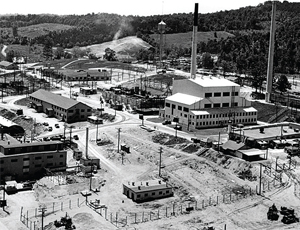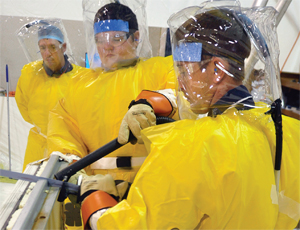“Exciting and bittersweet” is how Anthony Buhl, CEO of EnergX, a contractor at the U.S. Energy Dept’s Oak Ridge nuclear waste cleanup site near Knoxville, Tenn., describes his portion of the complex’s stimulus infusion gained early this year.



About $125 million of Oak Ridge's total of $755 million in new environmental funding under the American Reinvestment and Recovery Act is boosting his firm's efforts to remove huge stores of nasty transuranic (TRU) nuclear waste that date to the site's World War II-era Manhattan Project origins.But the firm's 86 new jobs and two extra work shifts seem almost minuscule in an area hard-hit by manufacturing and retail downsizing. EnergX's Website drew 4,250 resumes for the new jobs offered, and a job fair held last spring generated lines of applicants “more than 100 yards long all day long,” Buhl says. “These folks were excited to wait for three or four hours for a five-minute screening.”
Gerald Boyd, DOE Oak Ridge operations manager, says packaging and removal of TRU waste will now be completed by September 2011, one year ahead of schedule. More than 3,900 cu meters of solids and sludges will be shipped off-site for long-term storage. “It is one of our more serious environmental issues,” he says. “You can’t treat it and you can’t make it go away.” ARRA funding also will expedite other planned but unfunded site cleanup, including decontamination and demolition of huge industrial buildings. Buhl says Oak Ridge was where full-scale production of plutonium, a key bomb component, was first demonstrated decades ago, and its remaining waste stores are larger than at other DOE sites.
Oak Ridge also has received about $744 million in ARRA funds for energy-efficiency block grants, which it distributes to U.S. municipalities. It is one of four DOE facilities so designated, says Boyd. He says the site’s total ARRA funding will generate 1,500 jobs by the end of 2011; about 800 are already in place.
For EnergX, a 300-person Oak Ridge-based firm, the stimulus hiring was its largest ever done in such a short time. The firm was founded by Buhl, a former CH2M Hill Cos. vice president at the now-completed Rocky Flats cleanup site near Denver, in the late 1990s.
Most newly hired waste operators, radioactivity control technicians and quality control inspectors were unfamiliar with DOE nuclear materials, so EnergX put them through a three-month training blitz. Buhl says only a few “washed out” of the intensive operations and safety instruction. The new hires, who began work in earnest last month, will now make TRU waste processing a 24-hour-a-day operation, five days a week. A third shift on weekends could be added next year. “It is difficult and exacting work,” says Buhl. “Bottom line; it’s not for everyone.”
Even with the challenges of the fast-paced work, new hires such as A. J. Summers, an engineer laid off last year by a local equipment management consultant, feel fortunate. Summer, who spent six months doing home remodeling while looking for work, has been an EnergX quality control specialist since May.
“This work is tedious, but it’s critical and I’m permanent and happy to be here,” he says. “A lot of skill sets were lost by other companies, so we profited.”





Post a comment to this article
Report Abusive Comment